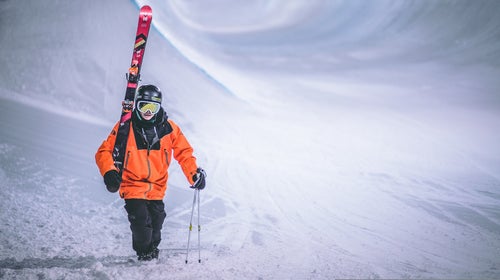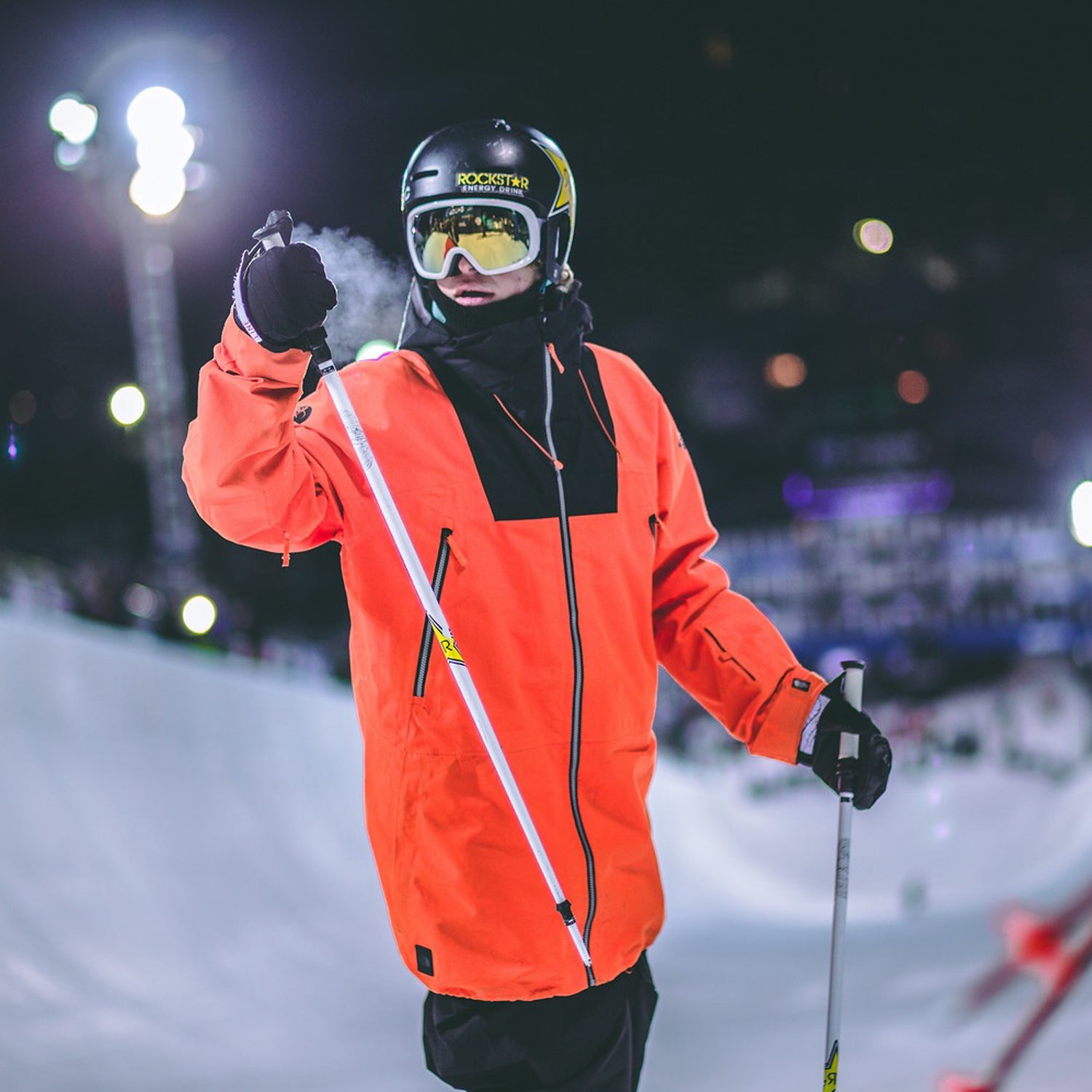In June 2016, Will Hagna, a senior designer for The North Face, and Austin Robbs, one of TNFŌĆÖs senior product managers, sat in a small room in the companyŌĆÖs offices in Alameda, California, drinking beers and trying to come up with a name for a new jacket. The ski coat, which would hit store racks in fall 2017, was tough, minimalist, and utilitarian, featuring few pockets, big Velcro pull tabs on the cuffs, and exposed zippers with oversized pulls. It came in gray, blue, and khaki. As Robbs describes it, the jacket was a reaction to the frilly ski clothing dominating the market. ŌĆ£We wanted to go in the other direction and create something that was clean-looking and extremely functional,ŌĆØ he says.
Surrounding Hagna and Robbs were mood boards, ten-foot-high pieces of cardboard plastered with photos of punk rockers, muscle cars, and concrete buildings. The photos were meant to be a reflection of the jacketŌĆöimages of things that are powerful, raw, classic, and functionalŌĆöand to help inspire a name for the new coat. The method was tried and true, having yielded more than 100 product names for Robbs and Hagna in the past. But a year earlier, while trying to figure out what to call the jacket, the duo fell off-course.
ŌĆ£WeŌĆÖd road-tripped to Jackson Hole and considered naming it after one of the towns along the way,ŌĆØ Robbs says. ŌĆ£The ElkoŌĆØŌĆönamed after Elko, NevadaŌĆöŌĆ£was circulating for a while, but it didnŌĆÖt quite fit. It almost seemed like an inside joke.ŌĆØ
Now Robbs and Hagna were running out of time. Inside the small room, they began homing in on the pictures of buildings designed by brutalist architects. Like the jacket they were trying to name, brutalist designs are known for ruggedness and functionality. But there was more to consider. When choosing a product name, Hagna and Robbs say they try to avoid alliteration (ŌĆ£Too cute,ŌĆØ Robbs says) and puns (ŌĆ£Too hokey and confusing,ŌĆØ Hagna says). And they aim to keep names to two syllables. ŌĆ£If thereŌĆÖs a lot to say, people donŌĆÖt like that,ŌĆØ Robbs says. ŌĆ£If itŌĆÖs more than three syllables, itŌĆÖs too cumbersome.ŌĆØ
ŌĆ£What about the Brutus?ŌĆØ Hagna asked. Derived from the French word brut, it conjured images of raw strength. The pair thought it would roll off the tongue and resonate with consumers. But thatŌĆÖs not the name the jacket ended up with.
Yeti Coolers and Yeti Cycles have a deal in place that sets clear naming boundaries. You wonŌĆÖt, for example, ever see Yeti Coolers put its name on a bike, even for promotional purposes.
What happened next is the classic story of how the outdoor gear we use is often christened with bizarre names. The ArcŌĆÖteryx , for example. Or FlylowŌĆÖs . Or PatagoniaŌĆÖs hoodie. Or, from TNF, the and jackets and the bib.
Hagna and Robbs sent 50 names, including Brutus (their favorite), to the companyŌĆÖs legal department for approval. Every one of them was rejected. ŌĆ£Ninety percent of the time, legal says no,ŌĆØ Robbs says. ŌĆ£They donŌĆÖt really give us the reasons, but itŌĆÖs mainly because weŌĆÖd be stepping on the toes of somebody else whoŌĆÖs already using the name to build a business.ŌĆØ
Once again, the pair went back to the mood boards. They still felt like brutalist architecture was the right note to hit, but this time they went a level deeper, considering names of buildings and the architects who designed them. One stood out: the Balfron Tower, an apartment complex in London that sort of looks like it was built using an Erector Set.
The name Balfron was esoteric, but Robbs and Hagna liked its originality, and it passed the legal departmentŌĆÖs smell test (the name of a jacket wouldnŌĆÖt infringe on the commercial success of a building). In October 2017, the hit retailers; so far, TNF has sold more than 1,000 of the jacketsŌĆöenough to consider the Balfron a modest success.
Naming gear wasnŌĆÖt always so complicated. In the past, product names were usually descriptive, often spelling out the exact use of the item. , for example, is one of the most iconic pieces of gear ever made. Built in 1981,┬ĀSpecializedŌĆÖs first mountain bike, the Stumpjumper, implied that the bike could, well, jump stumps. The product name was so popular that Specialized still builds a bike called the , even though it couldnŌĆÖt be more different than the original.
ŌĆ£Obviously, descriptive names have their advantages,ŌĆØ says Barbara Kahn, a professor of marketing at the University of PennsylvaniaŌĆÖs Wharton School of Business. ŌĆ£The problem is that most of those names exist now. When you consider legal issues, translation issues, and whatŌĆÖs available, it cuts down a whole lot of options.ŌĆØ
That dearth of alternatives can lead to crossover, which sometimes leads to lawsuits. In 2011, First Descents, a Colorado nonprofit that provides outdoor experiences for young adults with cancer, sued Eddie Bauer for a line of clothing it was calling First Descent, arguing that it infringed on its brand name. The case was settled, and Eddie Bauer stopped calling its line First Descent (though it continues to produce a line called First Ascent).
There are also examples of companies clashing over corporate names. In 2007, the U.S. Court of Appeals for the Second Circuit settled a long legal battle between Black Diamond Equipment, the Salt Lake CityŌĆōbased gear and clothing manufacturer founded in 1989, and Black Diamond Sportswear, a Vermont-based company founded in 1990, finding that Black Diamond Equipment had the rights to both the name and the logo. Black Diamond Sportswear subsequently went out of business.
Sometimes, brands work things out without the help of legal arbitration. Yeti Coolers and Yeti Cycles have a deal in place that sets clear naming boundaries. You wonŌĆÖt, for example, ever see Yeti Coolers put its name on a bike, even for promotional purposes. But for the most part, potential legal ramifications have caused a chilling effect when it comes to naming products in the outdoor industry. ŌĆ£Those situations make making up a word a dominant alternative,ŌĆØ Kahn says.
When Dan Abrams and Greg Steen, founders and owners of Flylow, brainstorm ideas for their ski and bike apparel, they often turn to 1970s and ŌĆÖ80s TV shows and movies, seeking out obscure character names that wouldnŌĆÖt already be assigned to a piece of outdoor apparel. ŌĆ£Say you look up the movie Fletch,ŌĆØ Abrams says. ŌĆ£ThereŌĆÖs all these names in there, and then, bam: the Irwin sock and the Frieda sock. Nobody owns those names. Nobody has put a trademark on the names Irwin or Frieda.ŌĆØ
At Yeti Cycles, at least one name was based on an inside joke. ŌĆ£We always said that we wouldnŌĆÖt make a 29er, because we thought they were dumb,ŌĆØ says Janette Sherman, marketing manager for Yeti Cycles. ŌĆ£We called them clown bikes. Then we realized theyŌĆÖre actually pretty great.ŌĆØ When Yeti named its first 29er, the company gave a nod to that preconception, calling it the Big Top.
Whether the name of a product has anything to do with its retail success is debatable. Kahn says that what really matters is the companyŌĆÖs brand recognition. ŌĆ£I instantly recognize The North Face logo,ŌĆØ she says. ŌĆ£ThatŌĆÖs what draws me in. The name of the coat isnŌĆÖt as important.ŌĆØ That might help explain why the names of some Patagonia products are uninspired: the and jackets, to name two.
For a smaller company like Flylow, Abrams argues that a product name can make a difference, noting that it can intrigue an otherwise indifferent retail-store buyer. ŌĆ£When youŌĆÖre doing a showing, you sometimes see buyers eyes gloss over, and then you mention the Shregging pant and it wakes them up,ŌĆØ he says. ŌĆ£TheyŌĆÖre like, ŌĆśThe what?ŌĆÖ And you say, ŌĆśYou know, a shred legging.ŌĆÖ You can ski or do yoga in it. That usually eases the tension, and they remember the name.ŌĆØ
Inside TNF offices, Robbs and Hagna are reminiscing.
ŌĆ£There was a jacket that Austin called the Oak Laser,ŌĆØ Hagna says. ŌĆ£It was a jacket that could go from the bar to the hill.ŌĆØ
ŌĆ£I live in Oakland, and it looked like a blazer,ŌĆØ Robbs says.
ŌĆ£I was like, what the hell is this? Oakland and a laser?ŌĆØ Hagna says.
ŌĆ£HeŌĆÖs never let me live that down,ŌĆØ Robbs says.
Not surprisingly, the jacket ended up with another bizarre name: the , a Latin word meaning ŌĆ£to bind together.ŌĆØ The men thought it was appropriate since the coat was a blend of mountain technical and ski-town chic. But that name posed problems because sales reps had trouble pronouncing it, which can make it confusing for customers.
Robbs says the pair learned a lesson from that. ŌĆ£Maybe we should just use climate-related names,ŌĆØ he jokes. ŌĆ£TheyŌĆÖre usually easy to say, and they sometimes work.ŌĆØ In fact, one of TNFŌĆÖs most successful jackets was the , which was named at a moment when the Weather Channel hosts were spending significant time discussing the polar vortex.
ŌĆ£Oooh,ŌĆØ Hagna says. ŌĆ£The Bomb Cyclone is great name for a jacket.ŌĆØ
ŌĆ£IŌĆÖll write that down,ŌĆØ says Robbs.


